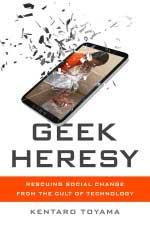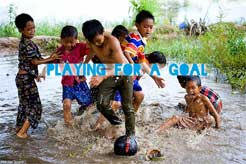By TRINA GORMAN
Kentaro Toyama, Geek Heresy: Rescuing Social Change from the Cult of Technology, New York, NY: PublicAffairs, 2015, 352 pp., $27.99 (hardcover)
My copy of Geek Heresy is tattered with highlights and scribbles. In this controversial yet inspiring book, Kentaro Toyama urges the development community to turn its focus from cookie cutter fixes to the people who provide and use the given fix – whether it be microcredit, school vouchers, or fancy gadgets. Poor people don’t need “turbo-charged, heat-seeking, robotic fishing poles” but rather, devoted/skilled/present teachers and mentors who nurture their capacity, and then decide whether a fishing pole is necessary. Toyama’s perspective is particularly compelling given his ironic career path. In 2005, he set out to study how technology can alleviate poverty, including co-founding a research group at Microsoft and an academic conference. But rather than proving what he hoped – that technology can promote socioeconomic development – he is now one of the leading skeptics in the field. Geek Heresy is a must read for anyone who is passionate about social change, though it’s particularly important for those who implement, fund, or evaluate technology projects.
Toyama begins with the position that “technology’s primary effect is to amplify human forces (29)”. He compares technology to a lever: when we use technology, both the degree of its effect (small or large) and its direction (positive, negative, neutral) are driven entirely by the intentions and capacity of those involved. Technology is therefore not a bridge for the digital divide but a jack—widening existing disparities since the rich benefit with a steep incline while the benefits for the poor are a mere dribble. He then explains how this same amplification effect applies to any partial, one-size-fits-all solution (or, “packaged intervention”). What determines whether a packaged intervention is effective is not the bednet/cash/mobile phone, but the existing human and institutional forces – or more specifically, the heart (good intentions), mind (knowledge and skills), and will (sweat equity) of beneficiaries as well as implementers. His proposed solution is to focus efforts on increasing these three traits through training and mentoring. Training creates more capacity to amplify. Mentoring ensures efforts follow the goals of beneficiaries, rather than paternalistic ideas. Toyama describes various organizations that use such a model; while each might use packaged interventions to fill a specific need, their primary purpose is to increase the heart, mind, and will of beneficiaries.
Toyama’s pull towards developing our human rather than our technical capacity is spot on. I too was once addicted to technology as a solution to poverty alleviation. But even post recovery, I have seen a great deal of money spent on technology projects that sound convincing on paper but were ultimately ineffective because of insufficient training and lack of continued support for beneficiaries. But nonprofits keep pitching the flashy ideas, and funders keep funding them. We need to get this book in the hands of nonprofits and funders.
- Poor people don’t need “turbo-charged, heat-seeking, robotic fishing poles” but rather, devoted/skilled/present teachers and mentors who nurture their capacity, and then decide whether a fishing pole is necessary.
- I have seen a great deal of money spent on technology projects that sound convincing on paper but were ultimately ineffective because of insufficient training and lack of continued support for beneficiaries. But nonprofits keep pitching the flashy ideas, and funders keep funding them.
However, if you are like me, you might leave Geek Heresy wanting more guidance about how to put Toyama’s ideas into practice. For example, at various points he describes the importance of quality implementation: “… it’s important that the emphasis be placed on good mentorship, not just the trappings of mentorship, or mentorship as a trendy buzzword (204, though also see 67, 70, 134).” While I agree in theory, good mentorship is arguably subjective and absolutely hard to measure. I would therefore have suggested that Toyama leave room for some practical questions such as:
- Assessment. What criteria should funders use to identify programs that are worthy of funding, given the absence of a Toyama-meter? Distinguishing good from trendy buzzword is particularly challenging when we need to assess programs from afar.
- Measurement. Given the many intangible benefits of educational programs and the need to show results to funders, what are the best measures of heart, mind, and will?
- Growth. Once successful, how can programs grow to multiply their efforts like Digital Green has without sacrificing the key elements of their program?
To be fair, Toyama set out to challenge our preconceived notions, rather than write an operations manual. Even so, it’s worth noting that funders will always be tempted by programs that help many people, quickly, and with concrete results. Therefore, educational programs will struggle to both attract and keep funding unless we have good answers to questions like these.
Overall, Toyama’s experiences have put him at the forefront of the technology for development movement. Everyone from field staff and managers to researchers and funders will benefit from his unique perspective; geeks and non-geeks, alike. Finally, we have a book that can help temper our technology addiction with an approach guided by critical thought and practical application.
—–
Trina Gorman is a Monitoring and Evaluation consultant, currently at the Bill & Melinda Gates Foundation. Prior to that she was Deputy Director for Innovations for Poverty Action’s Uganda office and Program Director at Literacy Bridge. The first six years of her career she spent at Microsoft as a technical writer.












